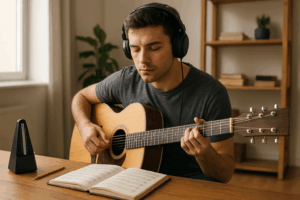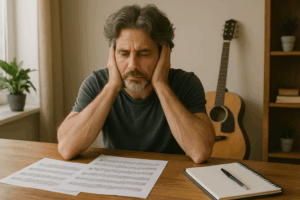As a beginner musician, you may not immediately realize how crucial finger strength is to your overall progress. Whether you’re learning an instrument like the guitar, piano, violin, or even drums, finger strength plays a vital role in your ability to play the instrument well.
Instruments that require finger movement, especially string and keyboard instruments, demand good finger strength and dexterity. Without it, pressing the strings, keys, or frets properly can be difficult, leading to muffled notes, poor tone quality, and, eventually, frustration. On top of that, lacking strength can also lead to joint strain or fatigue, potentially discouraging you from continuing.
The good news is that building finger strength is achievable with consistent practice and the right exercises. This article will delve into why finger strength is so important for beginners and provide a set of effective exercises that will help you develop stronger, more dexterous fingers over time.
Why Is Finger Strength Important?
The power and dexterity of your fingers determine your ability to create clear, consistent sounds on the instrument. This is particularly important in stringed instruments like guitars and violins, where proper pressure on the strings produces crisp, clean notes. Similarly, for keyboard instruments, the strength in your fingers allows you to control the dynamics of each key, giving you more expression in your playing.
In addition to improving the quality of your sound, finger strength also helps prevent fatigue. When you don’t have the necessary strength, you’ll tire faster during practice, which can lead to poor technique or even injury. This is why it’s crucial to build up finger strength early in your musical journey, so you can avoid these common pitfalls and practice effectively without strain.
Key Benefits of Finger Strength for Musicians
- Improved Sound Clarity: With strong fingers, you can press the strings or keys more firmly and accurately, which prevents muted or slurred notes.
- Better Control Over Your Instrument: The ability to adjust pressure on strings or keys gives you more control over the tone and dynamics of your music.
- Injury Prevention: Developing finger strength reduces the risk of repetitive strain injuries (RSI) or other hand-related injuries that can occur from playing for extended periods.
- Increased Endurance: With stronger fingers, you’ll be able to play for longer periods without tiring, leading to more productive practice sessions.
Exercises to Strengthen Your Fingers and Hands
Now, let’s take a look at some practical and simple exercises that can help build finger strength. These exercises are great for beginners and can be done at home with minimal equipment.
1. Tennis Ball or Stress Ball Squeezing
One of the most effective ways to build finger strength is through gripping exercises. Grab a tennis ball or stress ball and squeeze it as hard as you can. Hold the squeeze for 5 seconds, then release. Do this for about 10-15 minutes, alternating between hands. This exercise works your entire hand, including your fingers and wrist, helping to improve both strength and endurance.
Pro Tip: If you don’t have a stress ball, a rolled-up sock or towel can serve as a substitute.
2. Finger Flexion Exercises
Flexing your fingers individually helps increase the mobility and strength of each digit. To do this, stretch your hand out in front of you with your fingers extended. Slowly bend each finger one at a time towards your palm, hold for a few seconds, and then extend it back to the starting position. Repeat this process 10 times for each finger. This exercise isolates each finger, improving its strength and control.
3. Finger Tapping
Place your hand on a flat surface, like a table or desk, and tap your fingers one by one on the surface in a rhythmic pattern. Start with a slow tempo and gradually increase the speed as you become more comfortable. This exercise helps build dexterity and coordination between the fingers.
Pro Tip: Try tapping in different patterns to enhance your finger independence, such as tapping your index and middle fingers at the same time, then alternating.
4. Thumb Exercises
The thumb is an essential digit in many instruments, especially for fretting on string instruments or for piano players. To strengthen your thumb, place the tip of your thumb against the tip of each finger, creating a circular shape. Press gently for a few seconds, then release. Repeat this exercise for each finger. This will strengthen your thumb and improve its grip and control.
5. Scale Practice
Incorporating scale practice into your routine is one of the best ways to strengthen your fingers, especially for piano, guitar, and other stringed instruments. By practicing scales, you’re not only improving your finger strength but also your overall technique. Focus on playing each note clearly and maintaining the right amount of pressure on the strings or keys.
For beginners, it’s recommended to start with simple major and minor scales. As you become more comfortable, you can move on to more complex scales, such as pentatonic or chromatic scales.
Warming Up and Stretching: Essential Steps Before Practicing
Just as with any form of physical exercise, warming up before practice is critical for preventing injuries and maximizing your performance. Spend a few minutes stretching your hands and fingers before diving into your musical practice. This helps increase blood flow and flexibility, reducing the risk of strain.
Here are a few simple stretches to incorporate into your routine:
- Wrist Stretches: Extend one arm in front of you, palm facing upward. Use your other hand to gently pull your fingers back toward your body. Hold for 20-30 seconds and repeat on the other hand.
- Finger Stretch: Hold your hand out flat, and gently pull each finger back towards your wrist, holding for a few seconds on each finger.
- Thumb Stretch: Press the tip of your thumb gently against the tip of your pinky, stretching the thumb. Hold for 10 seconds.
Patience and Consistency: Building Finger Strength Over Time
Building finger strength doesn’t happen overnight. It’s important to be patient and consistent in your practice. Set realistic goals for yourself and track your progress over time. At first, your fingers may tire quickly, but with continued practice, you’ll start noticing improvements.
It’s essential to remember that over-exerting yourself early on can lead to burnout or injury. Begin with a few minutes of exercises each day, and gradually increase the time as your strength builds. This way, you’ll avoid unnecessary strain and allow your muscles to develop at a sustainable pace.
Finger strength is one of the foundational skills every beginner musician needs to master. By incorporating specific exercises into your routine and practicing regularly, you can build the strength and dexterity required to play your instrument more effectively and comfortably.
Remember, the journey of building finger strength is gradual. Be patient, stay consistent, and soon you’ll notice significant improvements in your playing. Whether you’re learning the guitar, piano, or any other instrument, finger strength will be one of the key factors in your musical success.




